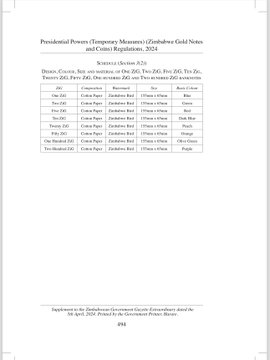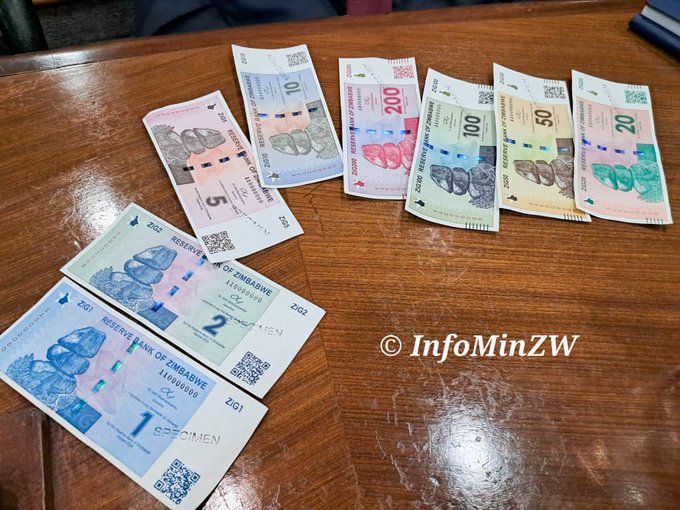Explainer: What is ZiG?
The Reserve Bank of Zimbabwe (RBZ) in the 2024 Monetary Policy Statement introduced a new “structured currency” termed ZiG (Zimbabwe Gold) on April 5.
A “structured currency” is a currency that is pegged to a specific exchange rate or currency basket and ZiG shall always be anchored and fully backed by a composite basket of foreign currency and precious metals (mainly gold) reserves.
According to official data, the ZiG is supported by RBZ reserve asset reserves, which include 2.5 tonnes of gold (worth US$185 million) and US$100 million in cash. The entire ZWL$ 2.6 trillion, or US$90 million equivalent, in reserve assets is sufficient to cover all of the reserve money in the system. These reserve assets total US$285 million.
ZiG banknotes and coins will be issued in denominations of 1ZiG, 2ZiG, 5ZiG, 10ZiG, 20Zig, 50ZiG, 100ZiG, and 200ZiG.
The ZiG notes are made from cotton paper, have the Zimbabwe Bird as their water mark and are all equal in size, measuring 155mm x 65mm.

The ZiG bank notes will enter circulation on Monday, April 8, 2024.
The half ZiG and coins will start circulating on April 30, 2024 to allow RBZ to carry out an educational and awareness campaign on the key security features of the ZiG notes and coins
The coming of ZiG has immediately replaced the Zimbabwe dollar (ZWL) as legal tender for settling all transactions and debts, private and public. ZiG will form part of the multicurrency basket and circulate with other currencies like the USD.
All ZWL banknotes, ZWL bank balances, ZWL mobile money accounts, and ZWL prices will be converted into ZiG using an exchange rate determined by the global price of gold as of 4 April 2024 and the ZWL interbank rate as of 5 April 2024.
ZiG started with an exchange rate of US$1: 13.5616 ZiG. This was based on the closing interbank exchange rate of US$1: ZWL33.904.9916 on April 5.
In accordance with the new monetary policy framework, the RBZ has adjusted the Bank policy rate from 130% to 20% annually.
The ZiG standardised the Statutory Reserve Requirements (SRR) at 5% for savings and time deposits and 15% for demand deposits.
When it comes to individual bank accounts, banks will not impose monthly maintenance or service fees if the daily amount is US$100 or less, or its equivalent in ZiG.
Companies will have to pay at least 50% of their taxes in ZiG on Quarterly Payment Dates (QPDs), according to a government mandate.
According to the Zimbabwe Coalition on Debt and Development (ZIMCODD), an accountability watchdog, Zimbabwe has been gradually building gold reserves since it changed payment modalities of royalties, where 50% is now settled in the physical form of the minerals.
“Apart from the accumulation of gold reserves, the ZiG is backed by foreign currency (USD) reserves accumulated through involuntary export surrender requirements. Exporting companies will continue to cede 25% of their export proceeds in exchange for ZiG,” said the accountability watchdog.
“To support the value of the structured currency, the Treasury will also demand that corporate taxes be settled using ZiG.”
ZIMCODD explained that from now on, ZiG’s money supply growth will only be limited to the growth of RBZ’s reserve asset holdings. In theory, this arrangement could restrict the ability of authorities to print ZiG willy-nilly.
Should this continue, the gold-backed ZiG will become a stable currency, slowing the dollarisation of the economy.
“Generally, gold is considered a safe haven investment during downturns and financial crises because of its long history of use as a store of value. Its properties are helping it achieve this status: malleability, portability, aesthetic appeal, virtual indestructibility, universal acceptance, liquidity, and rarity,” said ZIMCODD.
The watchdog noted that the officially shared specimen ZiG notes have a quick-response (QR) code that an imaging device can read.
“This likely indicates that authorities will soon adopt advanced technologies like blockchain and distributed ledger technologies. These technologies guarantee transparency and efficiency of transactions and are even difficult to disrupt,” said ZIMCODD.
“This ensures that all transactions are safely recorded, as no documents can be falsified since all data is immutable – anyone cannot modify it. This will circumvent the dangers of reliance on centralised, traditional database systems, which are highly prone to manipulation, may be hacked, and are susceptible to genuine human errors.”
Nevertheless, for ZiG to succeed, ZIMCODD stated authorities also need to adopt advanced technologies in gold production tracking and monitoring to minimise the chances of gold leakages and illicit trading.
“Traceability measures help curb criminality as information such as the exact source of gold, holder of gold buying license, and amount of taxes paid on gold exports can be collected and analysed,” said the organisation.
ZimCODD said the increase in ZiG money supply will only be permissible if there are enough gold reserves; hence, there is a need for a whole-of-government approach to curb illicit gold trading.
“Otherwise, the expected increase in import bill will render the ZiG worthless. Again, the ZiG concept will require frequent auditing of physical gold and USD cash reserves backing the currency by reputable and independent audit institutions,” said the watchdog.
“Suppose there are no trusted audits of the quantum of gold reserves in RBZ vaults versus issued structured currency (ZiG). In that case, the tokens risk suffering the same fate as bond coins and notes, which RBZ reportedly introduced under a US$200 million facility provided by Afreximbank.
“The market started to reject bond coins and notes like $2, $5, and $50 partly because authorities have printed more than they reported backing this surrogate currency, thereby causing increased depreciation pressures.”

